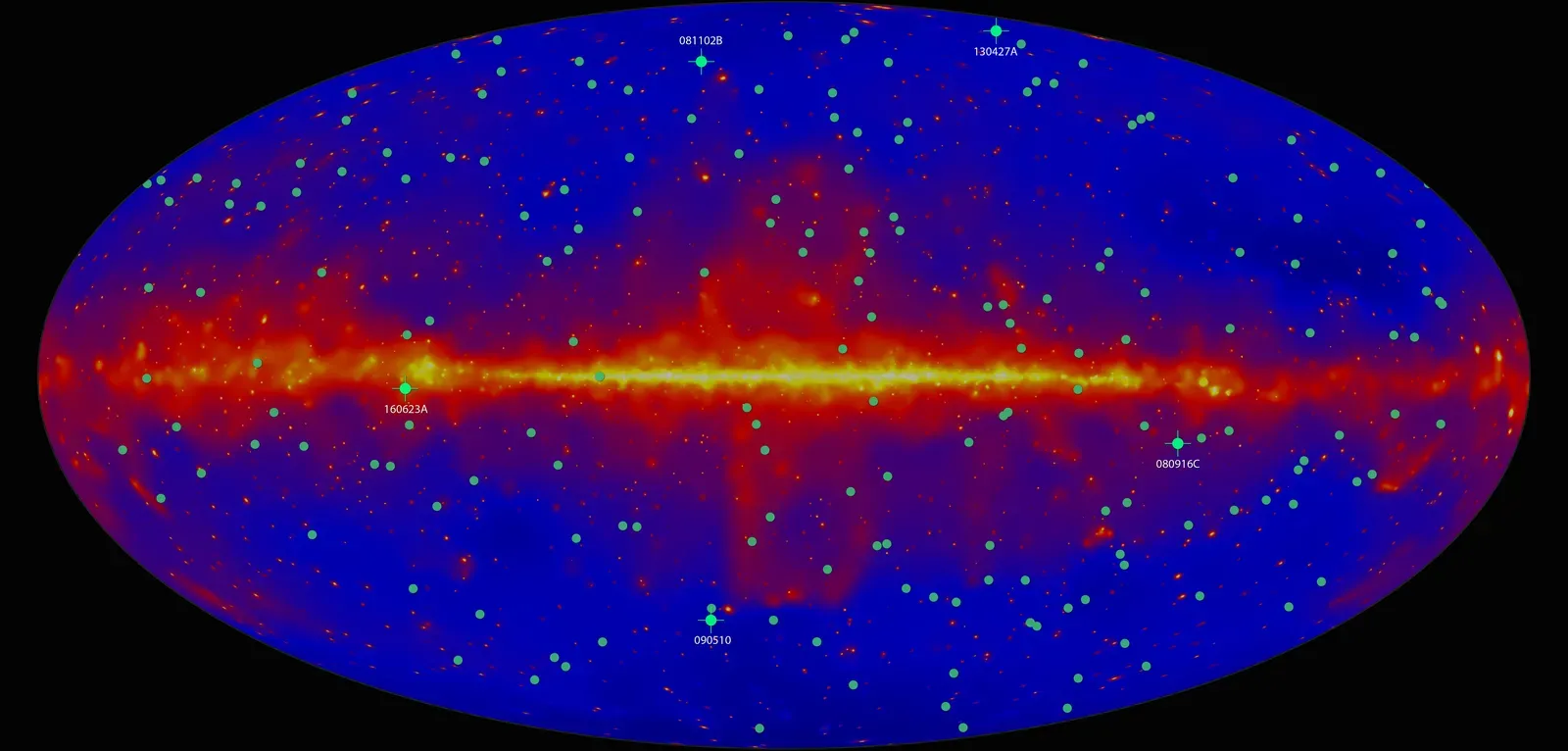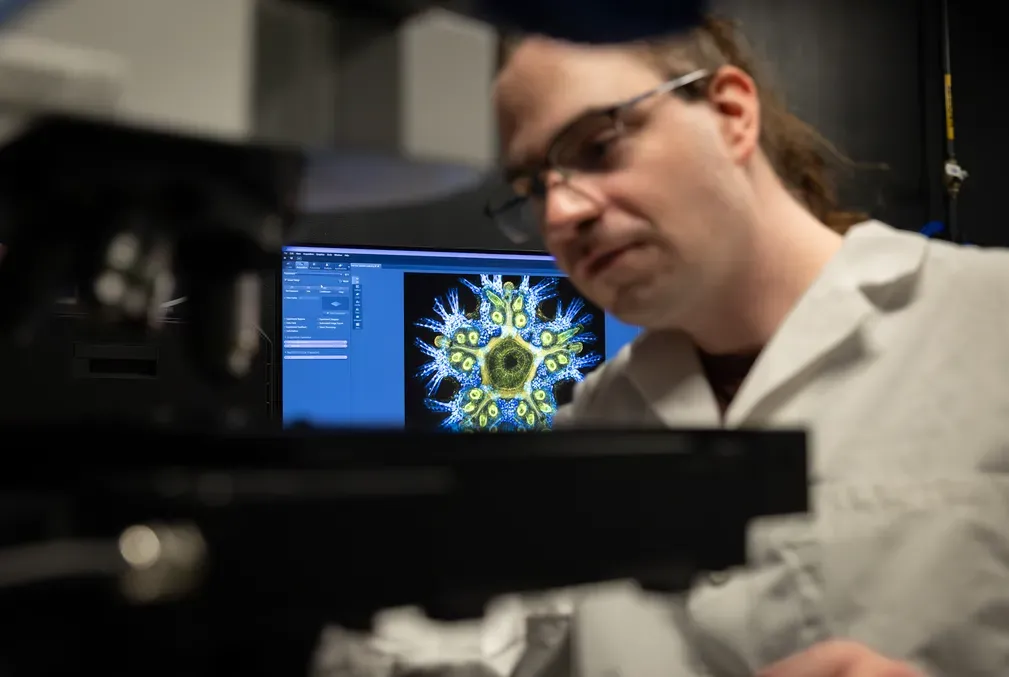
NASA’s Fermi mission reveals record-setting gamma-ray bursts
Green dots show gamma-ray bursts observed by the LAT during its first decade. Noteworthy bursts are highlighted and labeled. Background: the map shows how the gamma-ray sky appears at energies above 10 billion electron volts.
Stanford has played a leading role in compiling Fermi’s gamma-ray bursts catalogs ever since the space observatory launched nearly 11 years ago.
For 10 years, NASA’s Fermi Gamma-ray Space Telescope has scanned the sky for gamma-ray bursts (GRBs), the universe’s most luminous explosions. A new catalog of the highest-energy blasts provides scientists with fresh insights into how they work.
“Fermi is an ongoing experiment that keeps producing good science,” said Nicola Omodei, an astrophysicist at Stanford University’s School of Humanities and Sciences. “GRBs are really one of the most spectacular astronomical events that we witness.”
The catalog was published in the June 13 edition of The Astrophysical Journal and is now available online. More than 120 authors contributed to the paper, which was led by Omodei and Giacomo Vianello at Stanford, Magnus Axelsson at Stockholm University in Sweden, and Elisabetta Bissaldi at the National Institute of Nuclear Physics and Polytechnic University in Bari, Italy.
Stanford has played a leading role in compiling Fermi’s GRB catalogs ever since the space observatory launched nearly 11 years ago. “All of the analysis tools and methods that led to the preparation of the catalogs were developed at Stanford and SLAC,” Omodei said. “We’ve continued to refine the analysis techniques and increase the sensitivity of the Fermi Large Area Telescope (LAT) to GRBs. For every GRB, we can characterize its duration, its temporal behavior, and its spectral properties.”
GRBs emit gamma rays, the highest-energy form of light. Most GRBs occurs when some types of massive stars run out of fuel and collapse to create new black holes. Others happen when two neutron stars, superdense remnants of stellar explosions, merge. Both kinds of cataclysmic events create jetfers of particles that move near the speed of light. The gamma rays are produced in collisions of fast-moving material inside the jets and when the jets interact with the environment around the star.
Astronomers can distinguish the two GRB classes by the duration of their lower-energy gamma rays. Short bursts from neutron star mergers last less than 2 seconds, while long bursts typically continue for a minute or more. The new catalog, which includes 17 short and 169 long bursts, describes 186 events seen by Fermi’s Large Area Telescope (LAT) LAT over the last 10 years.
Fermi observes these powerful bursts using two instruments. The LAT sees about one-fifth of the sky at any time and records gamma rays with energies above 30 million electron volts (MeV) — millions of times the energy of visible light. The Gamma-ray Burst Monitor (GBM) sees the entire sky that isn’t blocked by Earth and detects lower-energy emission. All told, the GBM has detected more than 2,300 GRBs so far.
Included in Fermi’s latest observation set are a number of record-setting and intriguing events, including the shortest burst ever recorded (GRB 081102B, which lasted just one-tenth of a second), the longest burst in the catalog (GRB 160623A, which remained illuminated for 10 hours), and the farthest known burst (GRB 080916C, located 12.2 billion light-years away in the constellation Carina).
Also included in the new catalog is GRB 170817A, the first burst to have both its light and gravitational waves captured simultaneously. Light from the event — a product of two neutron stars crashing together — was recorded by Fermi’s GBM instrument, while the spacetime ripples it generated were detected by the Laser Interferometer Gravitational Wave Observatory (LIGO), the Virgo interferometer.
“Now that LIGO and VIRGO have begun another observation period, the astrophysics community will be on the lookout for more joint GRB and gravitational wave events” said Judy Racusin, a co-author and Fermi deputy project scientist at NASA’s Goddard Space Flight Center in Greenbelt, Maryland. “This catalog was a monumental team effort, and the result helps us learn about the population of these events and prepares us for delving into future groundbreaking finds.”
The Fermi Gamma-ray Space Telescope is an astrophysics and particle physics partnership managed by NASA's Goddard Space Flight Center in Greenbelt, Maryland. Fermi was developed in collaboration with the U.S. Department of Energy, with important contributions from academic institutions and partners in France, Germany, Italy, Japan, Sweden and the United States.



